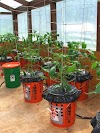Gardening
What is Trench Composting #Organic_Gardening
The next step is.....well, there is no next step.
Different Ways to Compost in Trenches
- Trench Rotation: This is a method of incorporating organic matter into a garden a bit at a time while maintaining active growing and path areas. The general ideas is that you divide your garden into three zones: a trench composting zone, a pathway zone, and a growing zone. Each year, you move the trench compost to a different part of the garden, and shift the paths and growing areas as needed. By the end of three years, you've got compost under every part of your garden bed, and you can start the rotation over again. If you like things very orderly, this is probably the method for you.
- Trenching Between Rows: This works in any vegetable or annual garden in which you would plant in fairly regularly-spaced rows. Basically, plant your crops as usual. In the space between the rows, dig a trench to toss your compostables into. Fill the trench as you add materials, and it will break down and nourish the plants nearby.
- ”Dig & Drop”: This is the easiest way to do trench composting, and works even in perennial gardens and shrub borders. Say you've collected a large bowl of vegetable and fruit peelings. Simply take it into the garden, dig a 12” deep hole wherever you can find a spot, dump the kitchen waste in, and cover it over. It's fast, it's easy, and it requires very little digging.







